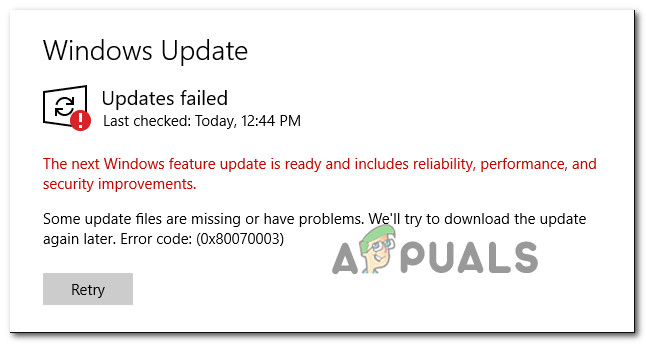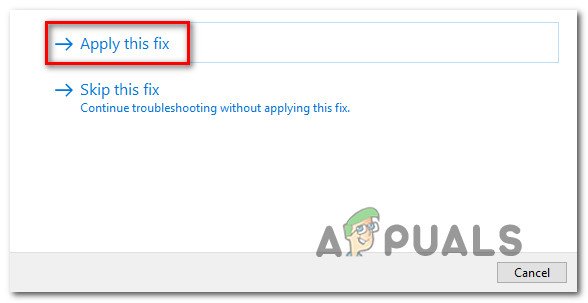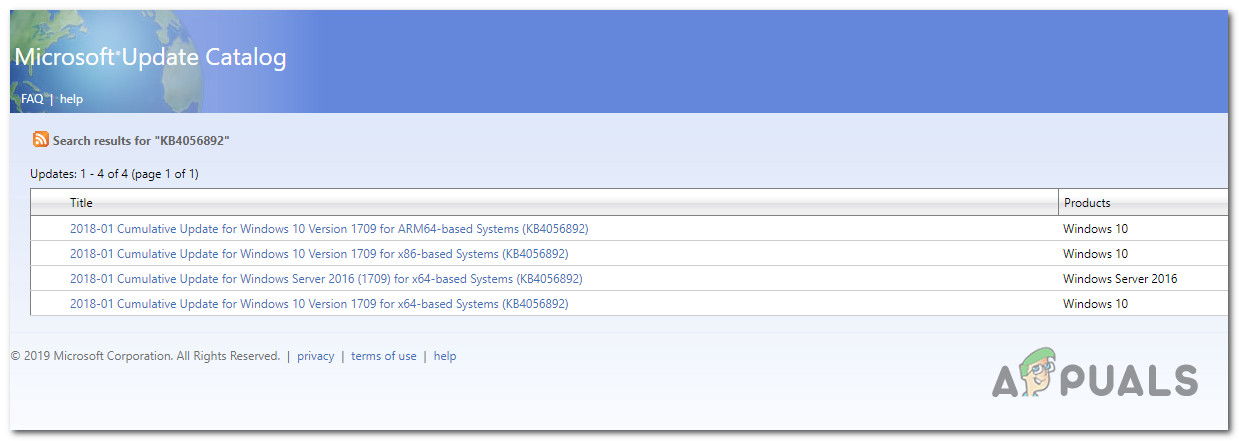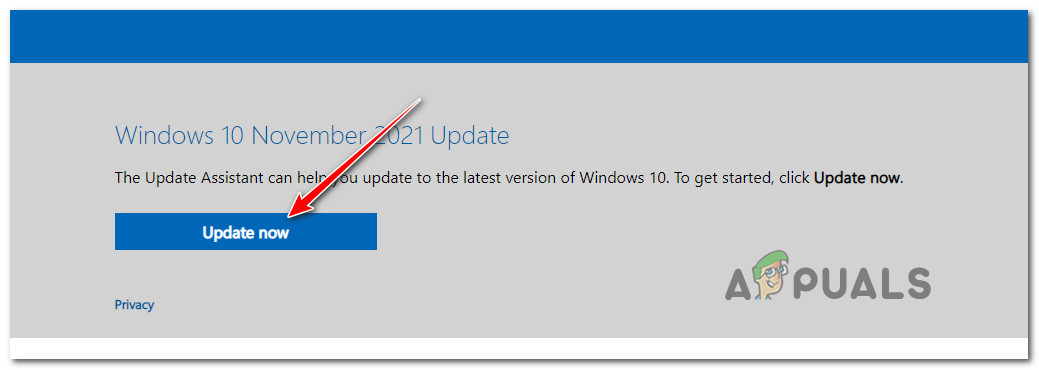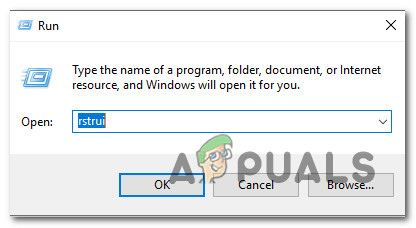After we’ve investigated this particular issue thoroughly, it turns out that there are actually several different underlying causes that might end up causing this error code. Here’s a shortlist of culprits: Now that we went over every potential scenario that might end up spawning the 0x80070003 error in your case, let’s go over each verified fix in order until you find the method that’s effective in your case.
1. Run the Windows Update Troubleshooter
If you’re encountering problems with Windows Update, and multiple pending WU updates are failing to install with the same 0x80070003 error, we recommend trying running the Windows Update troubleshooter. If you never used this utility before, the Windows Update Troubleshooter is, is designed to automatically identify and fix common problems. If you’re on Windows 11, you’re in luck as the utility is much more comprehensive than earlier versions. Microsoft has added dozens of new automated repair strategies that can be applied with just a few steps if a recognizable scenario is identified. If you haven’t tried this method yet, follow the instructions below to run the Windows Update Troubleshooter and apply the recommended fix automatically: Note: The steps below will work on every recent interaction of Windows 11, Windows 7, Windows 8.1, and Windows 10. If the Windows Update still fails to install with the same 0x80070003, move down to the next method below.
2. Clear the DataStore Folder
There are reports from many users who say they have also seen this issue when the Windows log file has corrupted references. This interferes with the process of keeping track of all installed Windows Updates. To fix this, you’ll need to delete the DataStore.edb file. If you’re looking for specific instructions on how to do this, we’ve created a step-by-step guide that will walk you through the entire process. Just follow the instructions below: In case the same issue is still occurring, move down to the next method below.
3. Restart the main Windows Update Service
Sadly, both Windows 10 and Windows 11 have a persistent bug where certain services are caught in a limbo state (neither opened nor closed) which makes them inaccessible during the process of installing a pending update. In this case, you can fix the issue by restarting the main Windows Update service from the Services screen. Note: This method will only work in a scenario where the main WU service and associated dependencies are not affected by corruption. For specific instructions on how to restart the main Windows Update service + dependencies by re-registering them via Command Prompt, follow the instructions below: If the same kind of error is still occurring, move down to the next method below.
4. Reset the Windows Update component
When investigating the 0x80070003 error message people often see when trying to install a Windows update, it turns out that there are a lot of Windows Update dependencies that could be responsible for the issue. If this scenario is applicable to you, then the first thing you should try is resetting the entire Windows Update component. In case you’ve come this far and none of the methods above have fixed the issue in your case, follow the instructions below to effectively reset the following Windows Update dependencies: MSI Installer, Cryptographic services, and BITS services. To make sure we don’t leave behind any corrupted instances, we will also clear the contents of the SoftwareDistribution and Catroot2 folders. Here’s what you need to do to enforce this fix: If the same kind of issue is still occurring, move down to the next method below.
5. Install the pending update manually
If the Windows Update component is not working correctly and the WU Troubleshooter cannot fix it, you can try installing the failing update manually by using the Microsoft Update Catalog. This directory can be used to download the compatible update version that is failing on your PC, and then install it manually with the .ini file. Note: It’s important to understand that this method will not fix the root cause of the issue (in case the 0x80070003 error appears due to some kind of corruption affecting the Windows Update component). However, it will allow you to bypass a corrupted Windows Update by allowing you to bypass the download and utilize external mirrors from MUC. For specific instructions on how to install a pending Windows update manually, follow the steps below: If the issue is still not fixed as you’re seeing the 0x80070003 even when attempting to install the pending update using the Microsoft Update Catalog, move down to the next method below.
6. Bring Your Windows up to date using Windows Update Assistant
If using the Microsoft Update Catalog didn’t allow you to install the pending update, a different route you can take is by using the Windows Update Assistant. This is an external tool that you can download and use to bring your Windows up to date. Important: If you have Windows 10 and you use this tool, you will be eventually upgraded all the way to the latest build of Windows 11. The main difference between this tool and the native way of installing the pending updates is that both the download and the installation parts are ‘outsourced’ on an MS server. Follow the instructions below to force the installation of the pending updates via the Windows Update assistant: If the steps above we’re interrupted at some point by the 0x80070003 error (or a different one), try the next method below.
7. Bring Your Windows up to date using Media Creation Tool
If the method above was a bust too, a final way to bypass the local Windows Update component is to use the Media Creation Tool. Keep in mind that we won’t be using it to clean install your current Windows version. Instead, we will perform an ‘upgrade’ which will essentially look for any missing update and install it in order to bring your windows built up to date. Note: Out of all the methods of bypassing the local WU component featured so far, this method has the highest probability of success since no local service is used because everything is handled externally. Follow the instructions below to update your Windows version to the latest via the Media Creation tool: If you’re still experiencing the 0x80070003 error during the updating process or something else interrupts the upgrading, move down to the next method below.
8. Deploy SFC and DISM Scans
The error code 0x80070003 is a common error that can occur when there’s an inconsistency due to corruption affecting Windows Update or an associated dependency. Most of the time, this error is caused by a damaged system file that’s preventing the auto-updating feature from working correctly. If this sounds familiar, the first thing you should do is run a few scans using the built-in System File Checker (SFC) and Deployment Image Servicing and Management (DISM) tools. While SFC and DISM have their similarities, we recommend running both scans one after the other for the best chance of fixing any corrupted system files. If this applies to you, begin with a basic SFC scan. Note: Keep in mind that this tool only works locally and won’t require an internet connection. Once you start the SFC scan, it’s important that you don’t close the CMD window, even if the scan appears to be frozen. Wait patiently until the process finishes, as interrupting it may cause logical errors on your hard drive or SSD. After the SFC scan is complete, reboot your computer and check if the issue has been fixed once the startup is finished. If you’re still seeing the 0x80070003 error when trying to run the Windows Update Troubleshooter, try running a DISM scan next and follow the on-screen prompts to finish up. Important: One key difference between SFC and DISM is that DISM uses a sub-component of Windows Update to download healthy equivalents of any corrupted system files it finds. Because of this, you need to make sure you have a stable internet connection before beginning this operation. After the DISM scan is successful, restart your computer once again and see if that has fixed the 0x80070003 error. If not, move on to the next potential fix below.”
9. Using the System Restore
If you’re still unable to install certain pending Windows Updates, you can try reverting your machine to a previous system restore point. This has helped some users fix the issue. Note: System Restore is a feature in Microsoft Windows that allows you to revert your computer’s state back to a previous point in time. This can be used to recover from system malfunctions or other problems. The only requirement of this method is to have a previously created snapshot that the utility can use to revert your PC back to a state in which this error was not occurring. Unless you modified the default behavior of System Restore, your PC should be configured to create these snapshots at important system events (you should have plenty of snapshots to choose from). Follow the instructions below to revert your PC back to a healthy state: If you’re still experiencing the same issue, move down to the final potential fix below.
10. Deploy a Clean Install or Repair install
If you haven’t had any success so far, it’s likely because you’re dealing with some kind of inconsistency that can’t be fixed in a conventional way. There are thousands of potential reasons for this problem since system files are so intertwined, so the best option would be to refresh all Windows files – this ‘nuclear option’ will effectively replace any corrupted Windows Update dependencies with healthy ones. When it comes to doing this, there are two available options:
Repair install (in-place repair) – This procedure only touches your system files and leaves everything else intact. This should be your first approach if you have essential personal data that you can’t afford to lose. But keep in mind that you’ll need compatible installation media.Clean install – This is the easiest procedure out of the bunch. You can deploy this operation without compatible installation media, but keep in mind that you’ll lose any personal files, documents, and media present on the operating system partition.
How to Fix Windows Upgrade Error Code 0x80070003 - 0x2000DFix: Error 0x80070003 When Updating AppsHow to Fix Windows Update “Error Code: Error 0x800706ba”?How to Fix Windows Update Error Code 0x80070437 on Windows 10?
